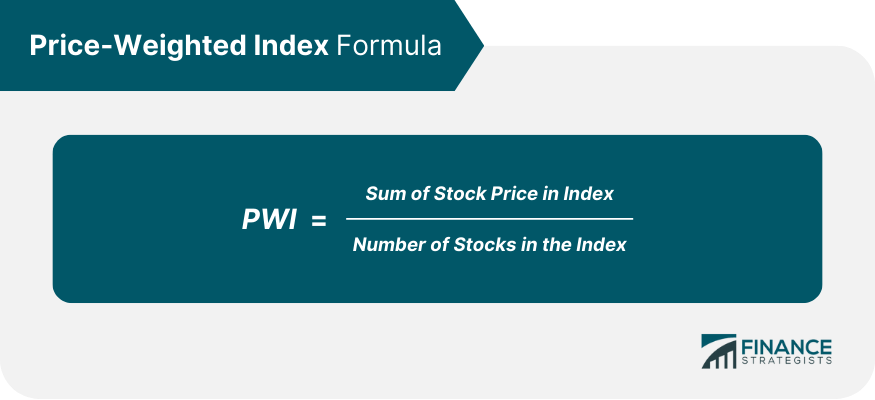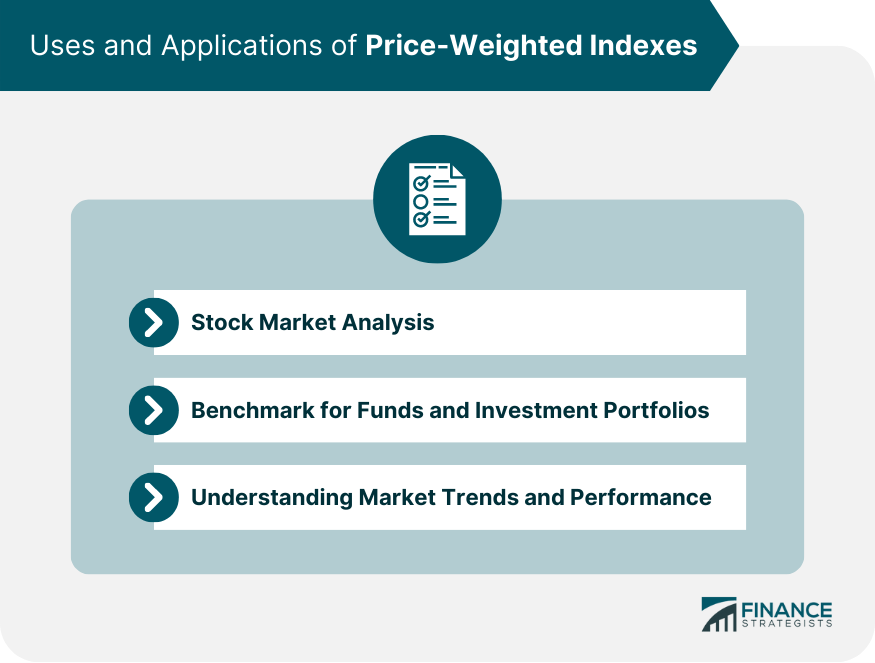A Price-Weighted Index is a type of stock market index where each constituent security is given a weight proportional to its price per share. In other words, higher-priced stocks have more influence on the index's performance than lower-priced stocks. The value of a price-weighted index is calculated by adding the prices of each of the stocks in the index and dividing by the total number of stocks. Common examples of this type of index include the Dow Jones Industrial Average (DJIA). However, it's important to note that this index structure may not accurately reflect the overall market or sector, as companies with higher share prices disproportionately affect the index regardless of their actual size or the total market value. A price-weighted index consists of stocks in which the price per share determines the weighting. In other words, the more expensive the stock, the greater the weight it has in the index. This structure is unique to price-weighted indexes and differentiates them from other types of indexes, like the market capitalization-weighted index, where the weight of each stock is based on its total market value. In a price-weighted index, the stock price per share is the most critical factor. This dependency implies that a stock with a higher price per share will have a more significant impact on the index's value, regardless of the size of the company. This characteristic can lead to some distortions as smaller companies with higher-priced stocks can have a greater influence on the index than larger companies with lower-priced stocks. Despite the simplicity of calculation and historical precedent, price-weighted indexes have certain limitations. Primarily, they do not accurately represent the overall market or specific sectors within the market, as the weighting is entirely dependent on the stock price and not the company's size or the number of shares outstanding. The basic formula for a price-weighted index involves adding the prices of each stock in the index and then dividing by the number of stocks. This simplicity makes the price-weighted index straightforward to calculate and understand. However, over time, changes like stock splits and dividends require adjustments to this basic formula. A stock split or dividend can significantly alter a stock's price, leading to distortions in a price-weighted index. To counteract this, the index's divisor is adjusted to ensure that such corporate actions do not affect the index's overall value. Over the years, adjustments and modifications have been made to the calculation process to better reflect the market conditions and accommodate corporate actions. These changes aim to ensure that the index continues to serve as a reliable tool for tracking market performance. The Dow Jones Industrial Average (DJIA) is the most well-known example of a price-weighted index. Founded by Charles Dow in 1896, the DJIA originally consisted of 12 industrial companies. Today, it includes 30 significant U.S. companies across various industries, serving as a barometer for the U.S. stock market. Japan's Nikkei 225 is another prominent example of a price-weighted index. It comprises the top 225 companies listed on the Tokyo Stock Exchange. The Nikkei 225 provides a comprehensive overview of Japan's corporate sector and is closely watched by investors around the world. While a price-weighted index depends on the stock price for weighting, a market capitalization-weighted index, such as the S&P 500, bases weighing on the total market value of a company (stock price multiplied by the number of outstanding shares). In this case, larger companies have more influence on the index performance. An equal-weighted index, as the name implies, assigns equal weight to all stocks in the index. Unlike a price-weighted index, an equal-weighted index doesn't give more influence to higher-priced stocks. This structure makes it a useful tool for avoiding bias towards any particular stock or sector. Price-weighted indexes are valuable tools for analyzing the stock market. They provide an easy-to-understand measure of market performance, enabling investors and analysts to track market trends and make informed decisions. Price-weighted indexes also serve as benchmarks for mutual funds and investment portfolios. Fund managers often compare their performance to these indexes to measure their success or failure. As a collection of selected stocks, price-weighted indexes are useful for understanding broader market trends and gauging the overall market performance. The most significant criticism of price-weighted indexes is the bias introduced by their price-based weighting system. It doesn't consider the size of the company or its overall market value, thus potentially misrepresenting the market's performance. Price-weighted indexes do not reflect the actual size of the market or a specific sector accurately. The stock price is not necessarily an indicator of the company's size or economic significance, making the index less representative of the market as a whole. Price-weighted indexes is also susceptible to non-economic factors. For example, a high-priced stock can unduly influence the index if it experiences significant price movement due to non-economic reasons. In response to criticisms, there have been evolutions in the calculation methodologies of price-weighted indexes. The aim is to make these indexes more representative of the overall market condition. For example, changes in the divisor calculation attempt to minimize distortions resulting from stock splits and dividends. The use of price-weighted indexes varies across different markets and exchanges worldwide. Some markets prefer price-weighted indexes for their simplicity, while others favor market capitalization-weighted indexes for their representativeness. This diversity reflects the ongoing debates about the effectiveness of price-weighted indexes. A price-weighted index, an essential tool in financial markets, assigns a proportional influence to each constituent stock based on its stock price per share. This distinct characteristic enables higher-priced stocks to have more sway on the index's overall performance. The calculation for such an index involves summing the prices of all the stocks and dividing by the number of stocks, but adjustments may be required to counter distortions from corporate actions like stock splits and dividends. Although the simplicity and historical precedent of the price-weighted index makes it a commonly used benchmark, it's important to remember its limitations, including its potential to misrepresent market performance due to its focus on stock price than company size. As investors and market analysts, understanding the price-weighted index and its characteristics is a fundamental part of financial literacy.Definition of Price-Weighted Index
Characteristics of a Price-Weighted Index
Structure of a Price-Weighted Index
Dependency on Stock Price Per Share
Limitations of Price-Weighted Indexes
Calculation of a Price-Weighted Index
Basic Formula and Its Application

Effect of Stock Splits and Dividends on the Calculation
Adjustments and Modifications to the Calculation Process
Examples of Price-Weighted Indexes
The Dow Jones Industrial Average (DJIA)
The Nikkei 225
Comparison Between Price-Weighted Index and Other Index Types
Price-Weighted Index vs Market Capitalization-Weighted Index
Price-Weighted Index vs Equal-Weighted Index
Uses and Applications of Price-Weighted Indexes
Stock Market Analysis
Benchmark for Funds and Investment Portfolios
Understanding Market Trends and Performance

Criticisms and Limitations of Price-Weighted Indexes
Price-Based Weighting System's Bias
Inability to Reflect the Actual Market or Sector Size
Effect of Non-economic Factors on the Index
Recent Developments and Changes in Price-Weighted Indexes
Evolution and Changes in Calculation Methodologies
Adoption and Rejection by Various Markets and Exchanges
Conclusion
Price-Weighted Index FAQs
A price-weighted index is a type of stock market index where each constituent stock influences the index in proportion to its stock price per share. In this type of index, higher-priced stocks have more influence on the index's performance than lower-priced stocks.
The calculation of a price-weighted index involves adding up the prices of all the stocks in the index and then dividing by the number of stocks. However, this calculation can be modified to accommodate corporate actions such as stock splits and dividends, which can distort the index value.
The Dow Jones Industrial Average (DJIA) and the Nikkei 225 are notable examples of price-weighted indexes. The DJIA includes 30 significant U.S. companies from various industries, while the Nikkei 225 consists of the top 225 companies listed on the Tokyo Stock Exchange.
The main criticisms of price-weighted indexes revolve around their price-based weighting system, which doesn't consider the size of the company or its overall market value. As a result, this can lead to distortions in the representation of market performance and an undue influence from non-economic factors.
Unlike a market capitalization-weighted index, which bases weighing on the total market value of a company, a price-weighted index depends on the stock price for its weighting. In comparison to an equal-weighted index, a price-weighted index gives more influence to higher-priced stocks.
True Tamplin is a published author, public speaker, CEO of UpDigital, and founder of Finance Strategists.
True is a Certified Educator in Personal Finance (CEPF®), author of The Handy Financial Ratios Guide, a member of the Society for Advancing Business Editing and Writing, contributes to his financial education site, Finance Strategists, and has spoken to various financial communities such as the CFA Institute, as well as university students like his Alma mater, Biola University, where he received a bachelor of science in business and data analytics.
To learn more about True, visit his personal website or view his author profiles on Amazon, Nasdaq and Forbes.











